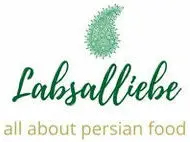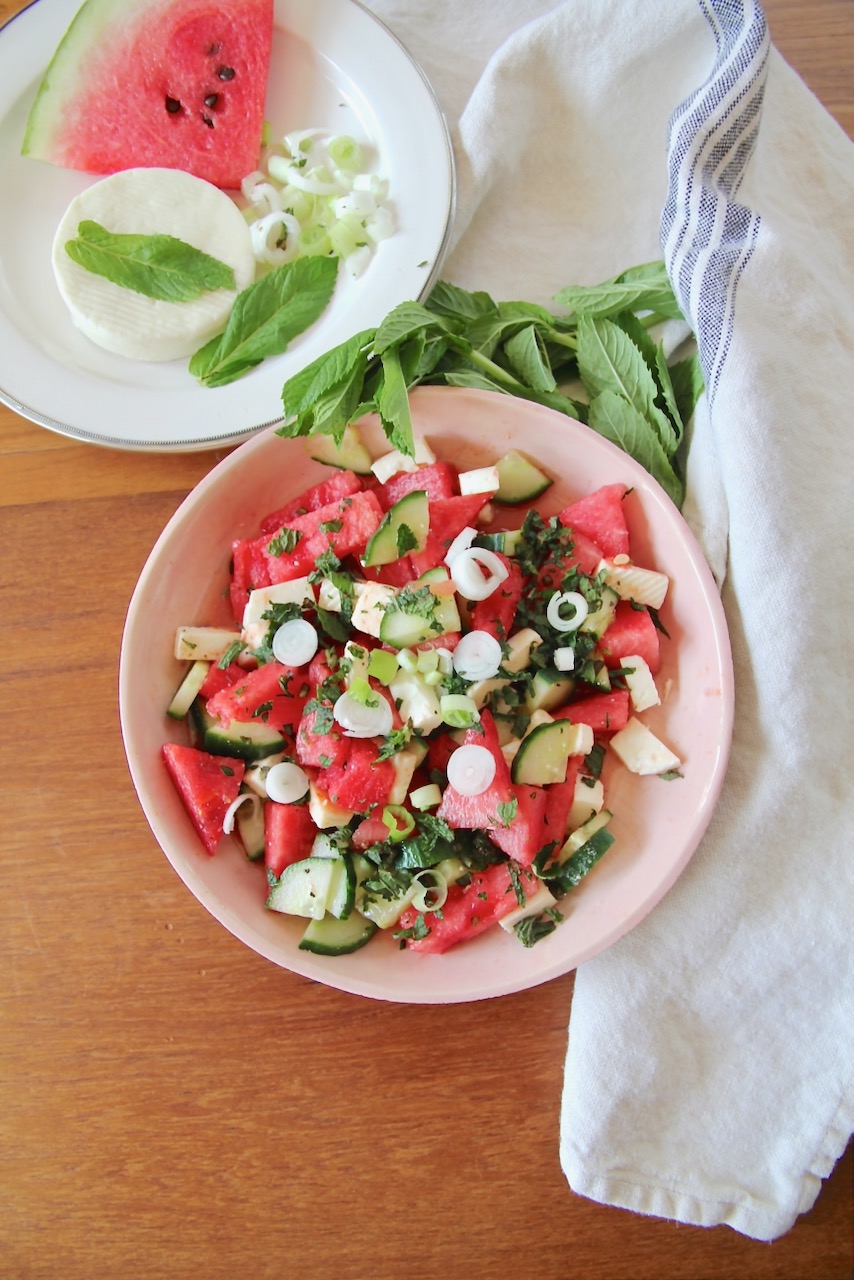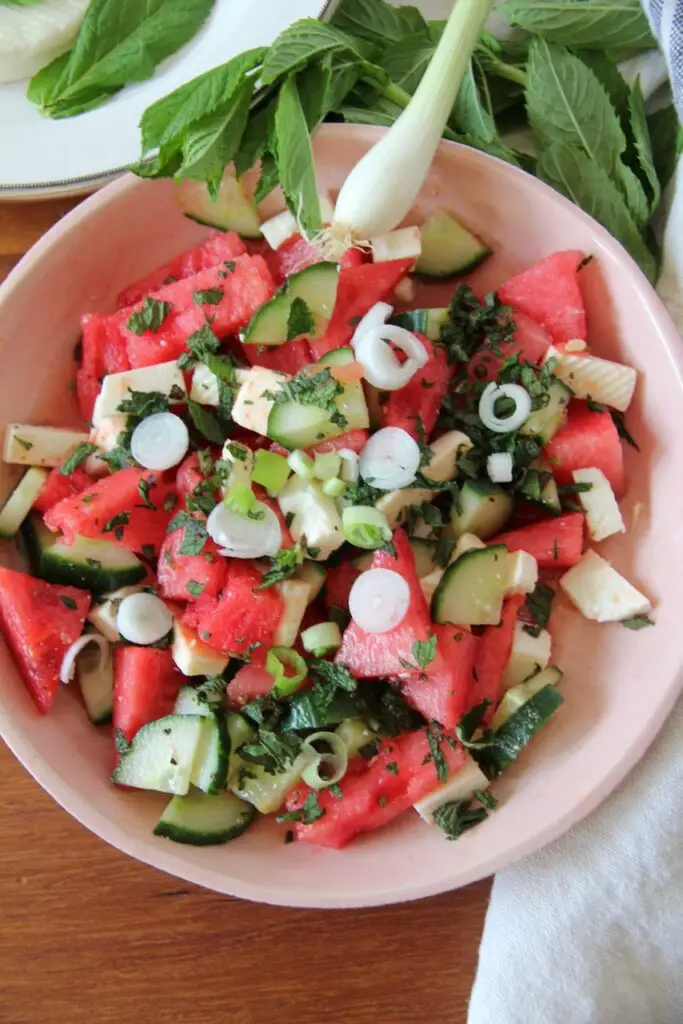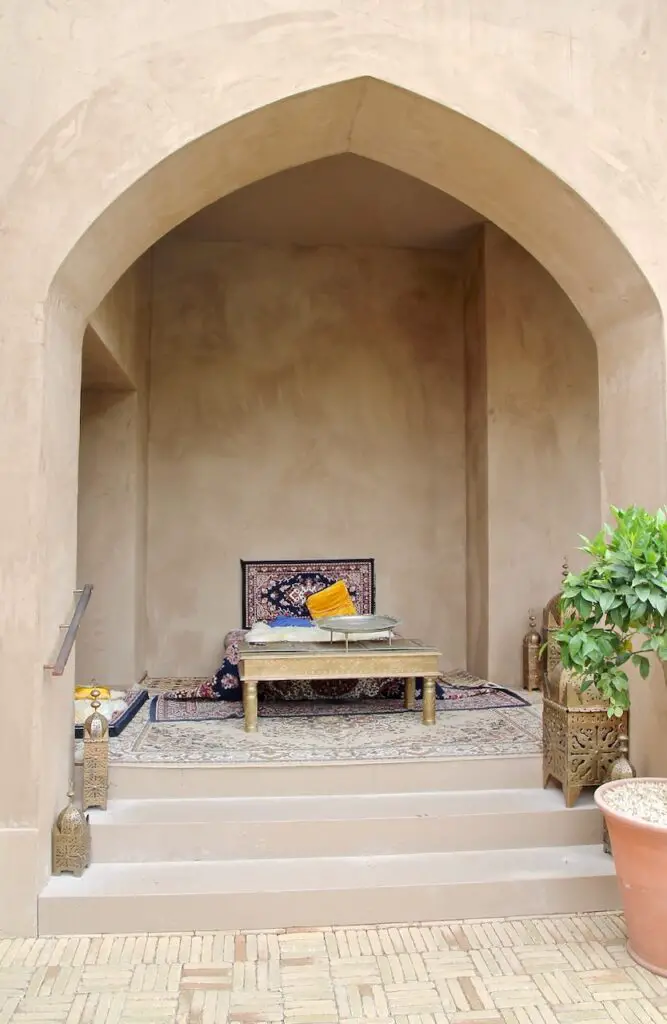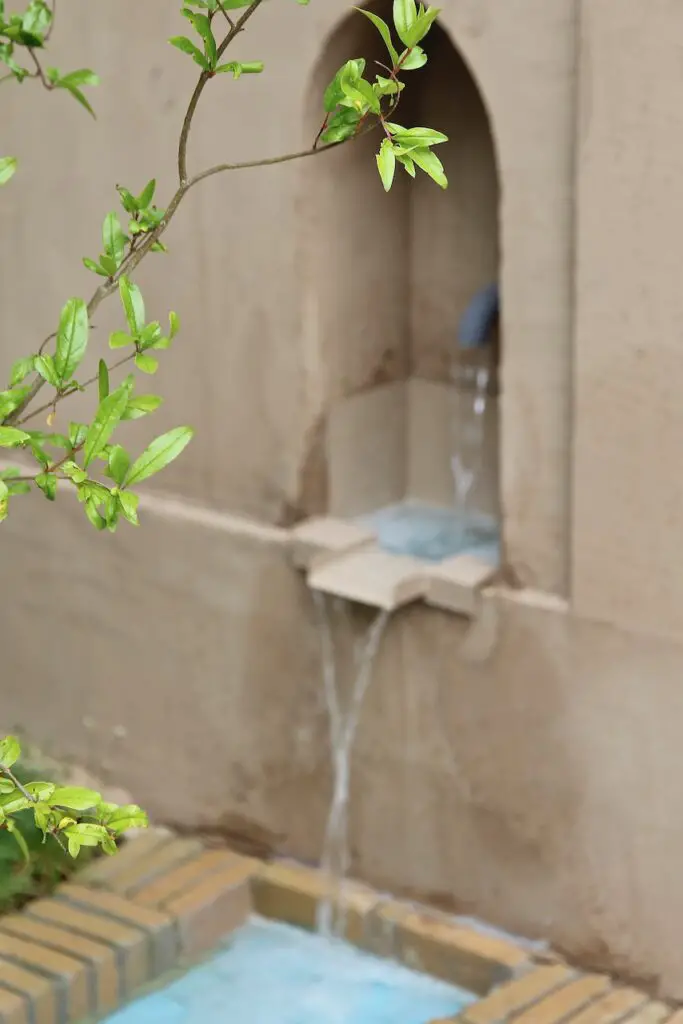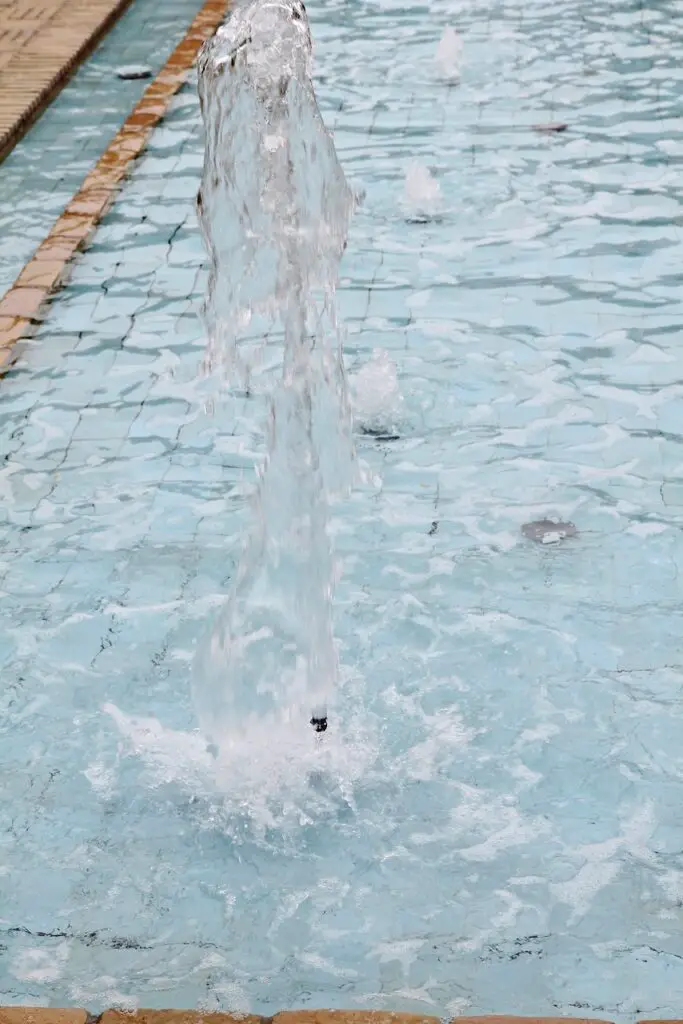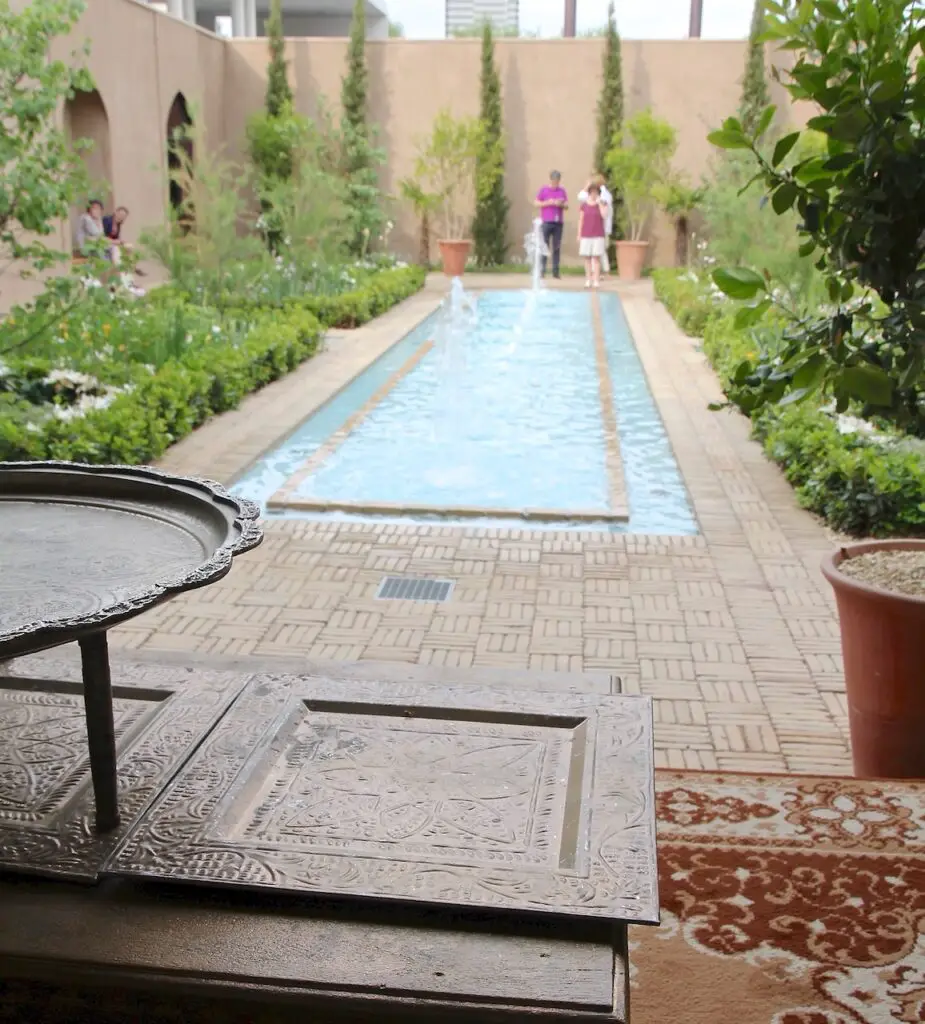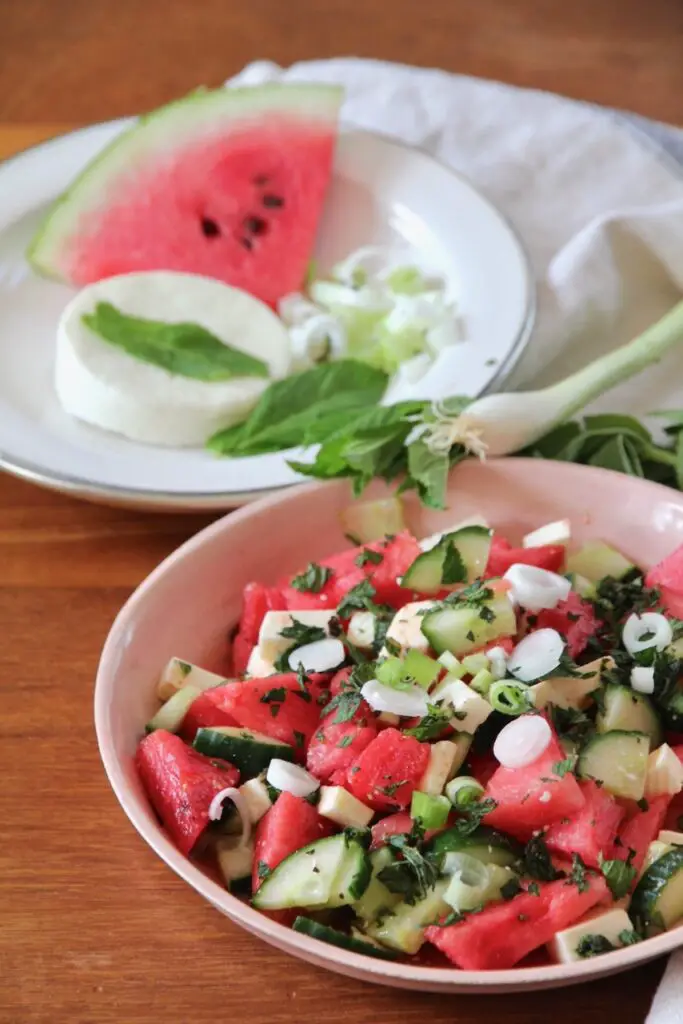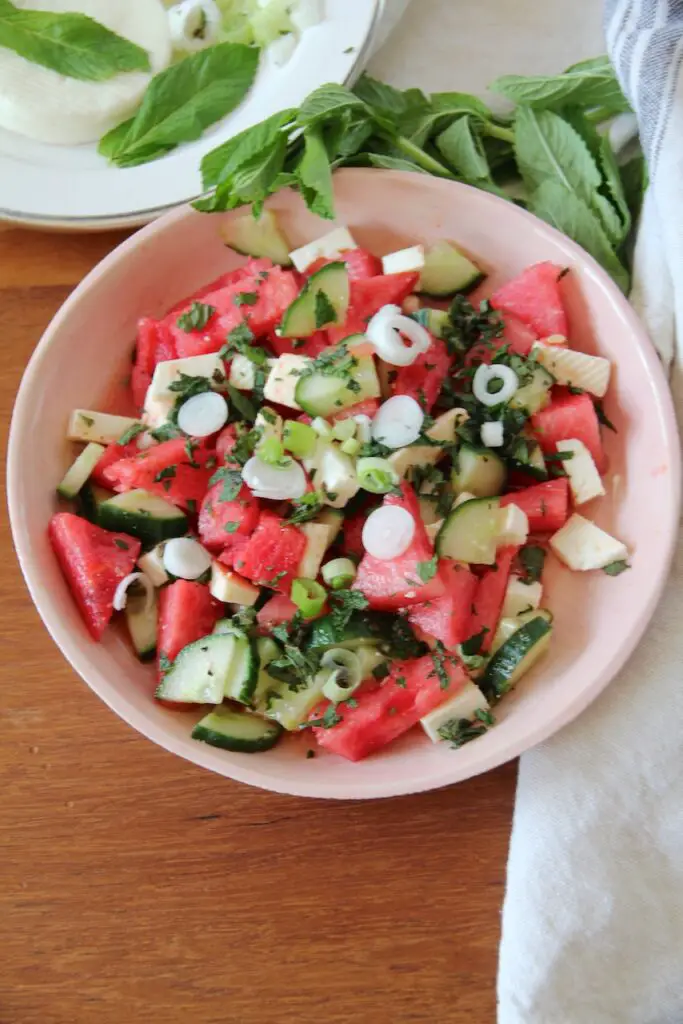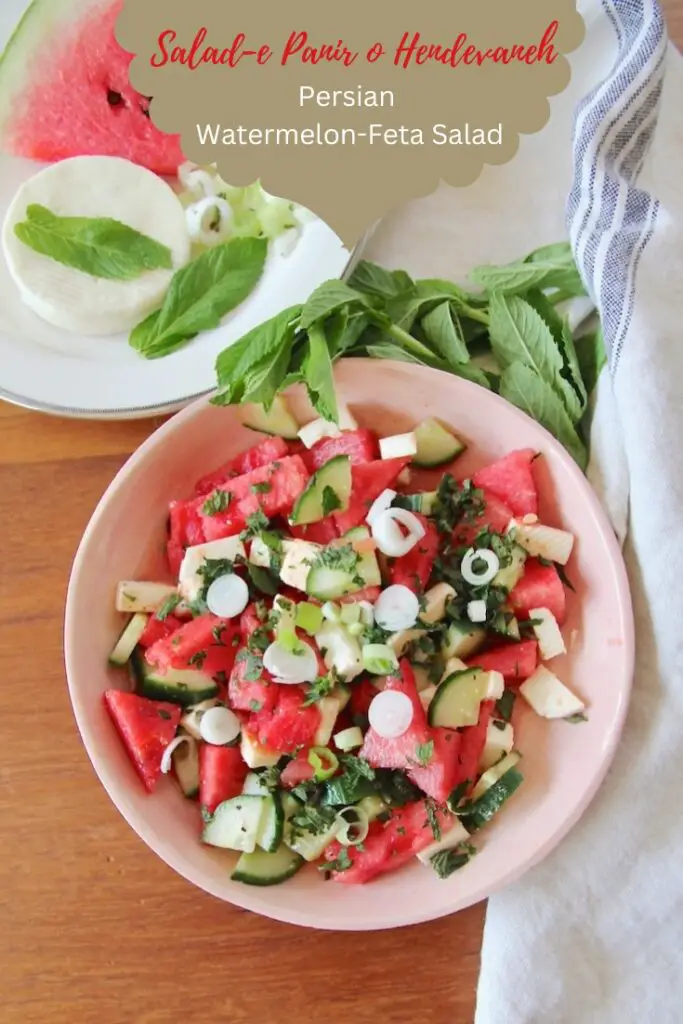Looking for a hit for your garden party? Try making Salad-e Panir o Hendevaneh—Persian watermelon salad with feta. This refreshing dish combines ice-cold, juicy watermelon with fresh cucumber, mint, spring onions, and salty feta cheese. It’s not only delicious but also super easy to prepare in just five minutes, making it the perfect choice for a hot day.
Watch my preparation video on Instagram
WATERMELON AND FETA SALAD – A TASTY REFRESHMENT
Watermelon is not only delicious but also packed with electrolytes like magnesium and potassium, helping to keep your body hydrated. In Iran, having an ice-cold watermelon on hand during summer is a must—it offers quick and refreshing relief from the heat. On hot summer days, we often enjoy watermelon on its own, as a juice, or paired with herbs and feta cheese. Interestingly, the vibrant red, white, and green of this dish also represent the colors of the Persian flag.
PERSIAN HOUZ – THE WATER BASIN
In Persia, watermelons can weigh up to 20 kilos. My father used to cool them down by placing them in cold water in the pool or in the “houz.” I remember being amazed that such a huge, heavy watermelon didn’t just sink. The houz, a water basin, is often the centerpiece of Persian gardens.
For the first few years of their marriage, my parents lived in my grandmother’s house. She had a beautiful hajat (Persian garden) with a shimmering turquoise houz at its heart. Surrounding the water basin were square flower beds filled with stunning Persian roses, their fragrance filling the entire garden when in bloom. She also placed pots of geraniums and herbs along the paths and around the houz, combining beauty with practicality.
Her houz was small but very deep, and every week a guy would come by to fill it with fresh water. In the summer, the houz was perfect for cooling drinks and fruit, and it also provided fresh, cool air. We loved sitting by the houz in the summer, enjoying chilled watermelon. After eating the juicy watermelon, we would place the rind on our foreheads to cool down—it felt amazing! As kids, we even bathed in the houz or simply dangled our legs in the water, soaking up the refreshing coolness.
PERSIAN DJUB – THE OPEN WATER CANAL
Outside the front door of our house was an open canal, known as a “djub,” with running water flowing along both sides of the road. As kids, we loved playing in the djub. We would try to push each other in or splash each other with the cool water.
Back then, the water was clear and clean, coming down from the surrounding mountains of Tehran and flowing to the southern parts of the city. Small concrete bridges occasionally crossed the djub, but most of the time, we just jumped over it. Sometimes, a car would get stuck in the djub with a tire, and all the neighbors would rush out to help lift the car out. For us kids, that was always great fun!
THE PERSIAN GARDEN
The Persian garden is a true feast for the senses, often considered a fragrant paradise. It serves as both an ornamental and kitchen garden, as well as a place to relax and celebrate. Hidden behind high walls, it’s a peaceful oasis that cannot be seen from the outside. These walls not only protect against noise but also provide shade, creating a calm and secure atmosphere. Behind ornate wooden doors lies the garden’s hidden beauty. As soon as the gate opens, you’re greeted by the soothing sound of water gently rippling in beautiful basins, offering both a pleasant melody and fresh, cool air.
The garden’s enchanting scent comes from a blend of roses, lilies, jasmine, and aromatic herbs like laurel and mint, gently teasing your nose. Meanwhile, delicious fruits like pomegranates, quinces, dates, olives, grapes, and oranges tempt your taste buds. Small palm trees, cypresses, and Judas trees offer shade, cooling your skin on warm days. The peaceful silence of the garden harmonizes the soul, creating a tranquil retreat.
In Germany, this style of garden is often referred to as an “oriental garden,” capturing the same sense of beauty and serenity.
COZY SEATING AREAS IN THE PERSIAN GARDEN
Cozy seating areas in the Persian Garden invite you to relax, celebrate, dance, play music, and sing with friends. In the past, during special occasions like weddings or Nowrooz (The Festival of Renewal), the water basin would be covered with planks and carpets. Actors and musicians would then provide entertainment. In Iran, this lively event is called “Rouhowsi,” which translates to “Rou” (on top) and “howsi” (water basin). Rouhowsi is similar to the Italian “Commédia dell’Arte” or stand-up theater, a form of improvisational performance.
Another tradition is the “Naqqal,” a storyteller who captivates the audience with tales of “Scheherazade” from 1001 Nights, poems from the “Diwan” by Hafez, or other oral tales and legends. Naqqali, an ancient Persian art of storytelling, involves the storyteller narrating, singing, and acting out the characters from these ancient stories and myths. Unfortunately, this beautiful art form is now almost extinct.
PLANTS IN A PERSIAN GARDEN
The plants in a Persian garden often hold symbolic meaning for the inhabitants of the house. Common plants include pomegranates, peaches, apricots, oranges, mint, laurel, cypress, yew, and mulberry trees. These trees are chosen not only for the shade they provide but also because the flowers and herbs often serve medicinal and culinary purposes.
WATER IN THE CENTER OF A PERSIAN GARDEN
Water plays a central role in a Persian garden, serving as both a key element and the garden’s focal point. The water basin, which can be simple or designed with intricate channels, fountains, cascades, or terraces, brings a sense of order to the garden and helps irrigate the plants. In holy scriptures, the water in the garden of paradise is described as a “source of eternal refreshment.”
The garden is often divided into four sections, known as “Chahar Bagh” (the four gardens) in Persian. These geometric shapes represent clarity and purity, symbolizing the four stages of life, with the water at the center representing the source of life.
FAMOUS PERSIAN GARDENS
Some well-known examples of Persian-inspired gardens outside Iran include the Taj Mahal in India, Madinat al-Zahra near Córdoba, the gardens of the Alcazar in Seville, and the Alhambra Gardens in Granada. These gardens reflect the classic design and beauty of traditional Persian gardens, showcasing their influence around the world.
THE PERSIAN GARDEN. THE INVENTION OF THE PARADISE
Until October 15, 2017, you have the chance to experience a stunning Persian garden at the Bundeskunsthalle in Bonn. This special exhibition, titled “The Persian Garden: The Invention of Paradise,” is part of the larger exhibition “Iran: Early Cultures between Water and Desert.” I had the opportunity to visit, and I was completely captivated—it’s an experience I highly recommend.
Start by exploring the Iran exhibition, then take some time to unwind in the beautiful Persian garden. The garden is filled with the enchanting scents of roses, jasmine, lilies, irises, and the soothing sound of rippling water. Stroll around the water basins, breathe in the aroma of lemon and orange trees, and admire the pomegranate trees, elegant cypresses, and Judas trees. You can also relax in one of the cozy wall niches or on the covered oriental terrace, lounging on carpets while taking in the breathtaking views of the garden.
“GARDEN OF THE FOUR STREAMS” IN BERLIN
In Berlin Marzahn, you can explore the beautiful “Gardens of the World,” which includes an enchanting Oriental garden. Opened in 2005, this garden is now part of the IGA (International Garden Exhibition), that took place in Berlin until mid-October of that year. I visited Berlin in early July to see the IGA, and I was especially excited to experience the Oriental garden.
FACTS ABOUT WATERMELON
Watermelon is not only deliciously fruity and refreshing, but it’s also packed with healthy benefits. It’s mostly water, low in calories, and rich in vitamin C, which helps protect your immune system and has anti-inflammatory properties. Plus, the vitamin A in watermelon boosts your skin’s metabolism, gives it a healthy glow, prevents dryness, and strengthens connective tissue. Watermelon also has a natural cleansing and draining effect.
In Iran, we love to turn watermelon seeds into a tasty, crunchy snack. Just roast the seeds in the oven with a bit of oil and salt, and you’ve got a healthy snack! These seeds are full of vitamins A, B, and C, as well as minerals like magnesium, calcium, iron, healthy fats, and even proteins.
Wondering how to pick a ripe watermelon? Here’s a simple trick: tap on the watermelon. If it makes a dull, full sound, it’s ripe. If it sounds hollow and soft, it’s still unripe.
INGREDIENTS PERSIAN WATERMELON AND FETA SALAD
500g watermelon
300 g cucumber
250 g feta cheese
1 tbsp white wine vinegar or
juice of one lemon
1 tbsp olive oil
1 handful of fresh mint
2-3 spring onions
salt and pepper
PREPARATION OF PERSIAN WATERMELON AND FETA SALAD
To prepare the Persian Watermelon Salad, start by cutting the watermelon into quarters, then slice each quarter into triangles.
Do the same with the cucumber—slice it, then cut the slices into small triangles.
Cube the feta cheese, and slice the spring onions, followed by chopping the mint.
In a bowl, mix vinegar or lemon juice, oil, salt, and pepper for the dressing.
Gently toss all the ingredients together with the dressing.
Serve the salad with sabzi khordan, a Persian herb platter, and Nan-e Barbari – Persian flatbread. Enjoy this refreshing and flavorful dish!
BEFARMAYID!
Susan
The items marked with * are affiliate links, referral links. If you buy through this link, I get a small commission. The price stays the same for you and you can easily support my efforts. A big thank you ♥
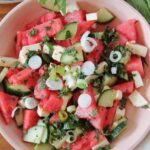
Salad-e Panir o Hendevaneh – Persian Watermelon and Feta Salad
Ingredients
INGREDIENTS PERSIAN WATERMELON AND FETA SALAD
- 500 g watermelon
- 300 g cucumber
- 250 g feta cheese
- 1 tbsp white wine vinegar or juice of one lemon
- 1 tbsp olive oil
- 1 handful of fresh mint
- 2-3 spring onions
- salt and pepper
Instructions
PREPARATION OF PERSIAN WATERMELON AND FETA SALAD
-
To prepare the Persian Watermelon Salad, start by cutting the watermelon into quarters, then slice each quarter into triangles.
-
Do the same with the cucumber—slice it, then cut the slices into small triangles.
-
Cube the feta cheese, and slice the spring onions, followed by chopping the fesh mint.
PREPARATION DRESSING
-
In a bowl, mix vinegar or lemon juice, oil, salt, and pepper for the dressing.
-
Gently toss all the ingredients together with the dressing.
Recipe Notes
Serve the salad with sabzi khordan, a Persian herb platter, and Nan-e Barbari – Persian flatbread. Enjoy this refreshing and flavorful dish!
Save the recipe for later on Pinterest!
Have you cooked this or maybe another delicious recipe of mine? Feel free to leave me a comment below. If you tag your picture on Instagram with @labsalliebe and use the hashtag #labsalliebe, I won’t miss a post and will be happy to leave you a comment as well. Can’t wait to see your creations.
♥♥♥♥♥♥♥♥♥♥♥♥♥♥♥♥♥♥♥♥♥♥♥♥♥♥♥♥♥♥♥♥
This website is created by me in my leisure under proper use of coffee 🙂 If you like my posts I would be happy if you donate me one or a few cups of coffee!
Donate an amount of your choice via Paypal.
♥♥♥♥♥♥♥♥♥♥♥♥♥♥♥♥♥♥♥♥♥♥♥♥♥♥♥♥♥♥♥♥♥♥♥♥♥
Sign up for my newsletter, and I’ll email you my latest recipes, travel reports, and trends once or maybe 2x a week for free.
